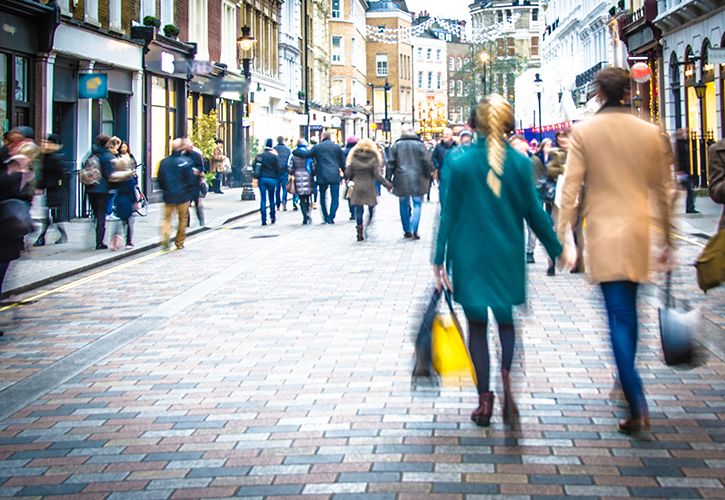UK DIY News
Barclays: Flat Consumer Card Spending Growth In March

Non-essential spending growth hits 18-month low in March, but cinemas and pubs benefit from blockbuster releases and major sporting events
- March’s 1.9 per cent increase in overall spending is on par with February (which saw the smallest boost since September 2022) as the rain hampered retailers and restaurants
- Essential spending remained flat at 2.4 per cent, while spending on non-essential items saw its smallest uplift since September 2022 at 1.6 per cent
- Encouragingly, new Barclays data shows rent and mortgage payments increased by just 1.8 per cent, far below the peak of 12.2 per cent, recorded in June 2023
- One in four Brits has participated in, or would consider taking part in, a “no-spend” challenge – where they refrain from all non-essential spending for a set period
- The Six Nations and St Patrick’s Day boosted pubs, while cinema spending reached a 2024-high on 2nd March, due to the much anticipated release of Dune: Part Two
- The Barclays Consumer Spend report combines hundreds of millions of customer transactions with consumer research to provide an in-depth view of UK spending
Consumer card spending growth flatlined in March, on par with February’s 1.9 per cent uplift, and significantly less than the latest CPIH inflation rate of 3.8 per cent. This was largely due to a slowdown in non-essential spending, which saw its smallest increase (1.6 per cent) since September 2022, as wet weather dampened both retail and restaurant sales. However, encouragingly, new data sourced from millions of Barclays current accounts* reveals growing stability in UK housing costs.
Retail spending remained almost flat at 0.7 per cent, brought down by falling in-store spending. Face-to-face retail (excluding groceries) was down -2.1 per cent and clothing fell -1.8 per cent, as spring showers deterred shoppers from visiting the high street. Meanwhile, restaurants had another challenging month, down -12.6 per cent, consistent with the fall witnessed in February (-13.4 per cent).
This comes as 45 per cent of consumers say they are continuing to rein in discretionary spending, with the majority (53 per cent) of this group cutting back on clothing and accessory purchases, and nearly half (47 per cent) spending less on dining out.
“No-spend” challenges emerge as latest thrifty trend
After reaching its highest point since November 2021 in February (59 per cent), consumers’ confidence in their ability to spend on non-essential items slipped to 55 per cent in March.
The slowdown in discretionary spending can also be attributed to the rise of the “no-spend” challenge, which involves consumers refraining from making non-essential purchases, such as takeaways, coffees and clothes, and instead prioritising essentials, such as food, childcare and utilities.
Almost a quarter of Brits (23 per cent) have participated in, or would consider participating in, a “no-spend” challenge. When asked about the most effective “no-spend” tactics, almost half (45 per cent) listed cooking more at home, while having clearly defined goals (such as saving for a holiday or building an emergency fund) and planning expenses in advance (37 per cent and 36 per cent respectively) also proved popular.
Dune: Part Two spurs cinema spending
Cinemas enjoyed their busiest day of the year so far on Saturday 2nd March, right after the UK release date for Dune: Part Two – 2024’s biggest grossing film – with spending 87 per cent higher compared to the average across the month.
On another positive note, pubs, bars and clubs saw stronger growth than in February, at 3.2 per cent compared to 1.1 per cent, as punters gathered to watch Six Nations and FA Cup fixtures, and to celebrate St Patrick’s Day.
Subdued supermarket sales
Spending on essential items grew 2.4 per cent, close to February (2.3 per cent). This was propped up by a noticeable recovery in fuel (-7.1 per cent) compared to February (-12.2 per cent) owing to petrol and diesel price increases.
Grocery spending, up just 2.7 per cent, recorded its slowest growth since September 2022, due to falling food price inflation, which reached its lowest level (5.0 per cent) since January 2022. Despite this, concerns about general inflation have risen to 87 per cent, after hitting a record low last month (84 per cent). Consumers are also increasingly concerned about the impact of shrinkflation, at 80 per cent versus 78 per cent the previous month.
Settling down: UK mortgage and rental payments stabilise
Encouragingly, new data sourced from millions of Barclays current accounts* reveals growing stability in UK housing costs. Last month, Brits spent just 1.8 per cent more on mortgage and rental payments than they did in March 2023. This was far below the 12.2 per cent increase recorded in June 2023 (when growth was at its highest), and the lowest year-on-year increase on file since March 2023.
However, not all consumers are back on solid ground – one in six (16 per cent) aren’t confident about their ability to meet their mortgage or rental payments, and 18 per cent of those with mortgage/rent payments are adjusting their spending habits to cope with rising housing costs. More broadly, consumers’ confidence in their general household finances remained steady in March, at 67 per cent.
To generate additional income, a relatively small percentage of homeowners (3 per cent) have started renting out a room in their house in the past year. However, this figure rises to 12 per cent for homeowners in London. More broadly, household spending (e.g. DIY and electronics) fell -5.2 per cent in March, with one in six (16 per cent) holding off home renovations due to current economic pressures.
Meanwhile, many renters say they’re losing out because demand is outpacing supply; 22 per cent feel there is too much competition for rental properties in their area, resulting in less value-for-money.
Karen Johnson, Head of Retail at Barclays, said: “Retailers were braced for a more subdued start to 2024, and recent figures are in line with expectations. The wet weather has been a key factor in the slowdown in discretionary spending, as it’s meant fewer visits to the high street and to hospitality venues.
“However, in spite of this initial lull, many retailers are confident that spending will rebound in the coming months, particularly in anticipation of better weather, the energy price cap drop, an uplift in the National Minimum Wage, and the buzz around major events such as Taylor Swift’s Eras Tour and the Paris 2024 Olympics.”
Mark Arnold, Head of Savings & Mortgages at Barclays UK, said: “Non-essential spending is still reeling from last year’s spike in housing costs, which caused both homeowners and renters to cut back while looking for additional sources of income – such as delaying renovations and renting out spare rooms.
“However, there are reasons to be optimistic – our data shows that housing costs are stabilising, the inflationary tide is easing, and interest rates are predicted to fall over the coming months, all of which should translate into increased consumer confidence and spending.”
Jack Meaning, Chief UK Economist at Barclays, said: “While still only tentative, the signs that the UK economy is expanding into 2024 continue to build. With an expectation that the Bank of England will cut interest rates from June, and banks responding by reducing mortgage rates, our research suggests that the housing costs that have been a drag on consumers for over a year are on the cusp of a turn, and will become a boost to spending from H2 and beyond. Today’s data shows this transition happening in real time.”
Overall growth figures
Spend Growth | Transaction Growth | |
Essential | 2.4% | 2.3% |
Non Essential | 1.6% | 2.6% |
|
| |
OVERALL | 1.9% | 2.5% |
Retail | 0.7% | 2.2% |
Clothing | -1.8% | 3.1% |
Grocery | 2.7% | 2.8% |
| 2.8% | 2.2% |
| 1.4% | 5.9% |
Household | -5.2% | 2.2% |
| -7.4% | -1.2% |
| -2.8% | 5.0% |
| -5.0% | 1.7% |
| 1.3% | 4.0% |
General Retailers | 3.4% | 2.7% |
| 5.9% | 6.4% |
| 0.1% | 2.9% |
| -6.8% | -10.4% |
Specialist Retailers | -0.6% | -1.8% |
| 4.2% | 0.3% |
| -4.6% | -6.3% |
| -2.9% | -3.1% |
Hospitality & Leisure | 4.7% | 3.1% |
Digital Content & Subscription | 7.7% | 6.3% |
Eating & Drinking | 2.6% | 0.1% |
| -12.6% | -15.0% |
| 3.2% | 2.3% |
| 3.0% | -0.7% |
| 5.4% | 1.4% |
Entertainment | 3.1% | 5.2% |
Hotels, Resorts & Accommodation | 1.0% | -1.0% |
Travel | 7.8% | 8.6% |
| 7.1% | 12.6% |
| 9.7% | 13.4% |
| 4.0% | 5.2% |
| 11.1% | 15.8% |
Other | 1.1% | 1.7% |
Fuel | -7.1% | -3.1% |
Motoring | -2.7% | 2.2% |
Other Services | 8.4% | 8.2% |
Insperiences | 3.6% | 2.1% |
|
|
|
Online | 3.5% | 5.8% |
Face-to-Face | 0.6% | 1.2% |
Source : Barclays
Image : William Barton / shutterstock / 610869530
Insight DIY is the only source of market information that I need and they always have the latest news before anyone else.











































